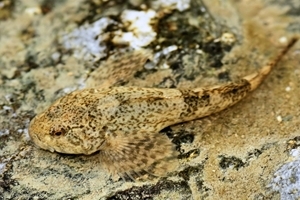Bullhead
 Every so often you come across a plant or animal that looks as if it might be in the wrong place. When I first saw a bullhead (Cottus gobio) on a fish survey in a stream near the coast of Anglesey, I thought it was a marine goby that was terribly lost.
Every so often you come across a plant or animal that looks as if it might be in the wrong place. When I first saw a bullhead (Cottus gobio) on a fish survey in a stream near the coast of Anglesey, I thought it was a marine goby that was terribly lost.
The bullhead is a member of the spiny-finned ‘sculpin’ family of fish, which consists of about 300 species worldwide, the vast majority of which live in marine environments and are similar in appearance to gobies. The bullhead is the only freshwater-dwelling species of sculpin in the UK. A widely distributed and versatile fish, it is found across Europe in watercourses ranging from chalk streams to lakes and moor becks.
Bullhead have the typical features of sculpins – that is, they are only around four inches long and rather toad-faced, with prominent eyes and a wide mouth. Their skin is slimy because they have few scales, and they are usually mottled brown in colour, though males turn almost black in breeding season. Their bodies taper towards the tail, so much so that one of the nicknames for bullhead is miller’s thumb, because they are fat and stubby at one end like the deformed thumbs of flour mill workers in yonder years!
To enable a bottom-dwelling lifestyle, bullhead have no swim bladder and their eyes point upward for enhanced predator-spotting. The eyes have a double cornea with a fluid layer in between, which helps protect them from passing objects and surfaces as they bury into stones. The huge fan-like pectoral fins have big spines on the bottom edge to grip the riverbed and help them stay put in fast flows.
The bullhead is seldom encountered by people because it spends much of its life under cobbles and stones to forage for aquatic invertebrates and evade predators. They are rarely caught by anglers, but river ecologists doing kick-samples for invertebrates often find them in the net, and they can form a considerable amount of the catch during electrofishing surveys in small stony streams and rivers.
Adults are very territorial, and live under a favourite stone that they will defend from invaders by wafting their fins and making warning sounds described as ‘knocking‘. Bullhead can spend their whole adult lives in possession of the same stone, and they have a ‘homing’ instinct, so if they are moved or washed away from their humble abode they will often find it again!
Bullhead have got parenting all figured out, and utilise a different strategy to most freshwater fish. The male excavates a ‘nest‘ underneath his home stone, and nearby females will choose their favourite nest. She lays up to 400 orange eggs on the underside of the home stone, which the male then fertilises and guards. A diligent father, he fans cool, oxygenated water over the eggs and patrols the nest, hoiking out predators that have sneaked in, such as cased caddis-fly larvae, which are well camouflaged inside their stick, leaf or stone cases.
Body size, life expectancy, laying frequency and colourations are variable depending on habitat conditions. This is hardly surprising given the broad spectrum of watercourses bullhead are found in. For example, they can live around four years in lowland hard waters and up to ten years in softer waters such as upland becks. That’s assuming they can avoid their usual predators: pike, chub, perch, grey heron, kingfishers and dippers.
Bullhead are a UK priority species and are mentioned in the designations of many watercourses. Because they require clean stony substrate with well-oxygenated water, they are vulnerable to silt and sediment accumulations and nutrient enrichment. They’re also under threat from extra predation pressure by invasive American signal crayfish and stocked rainbow trout, and bullhead nests can be casualties of spates after extreme rainfall, which are becoming increasingly common.
I read with some surprise that bullhead may have been persecuted by anglers in the past, due to a perception that they gobble eggs of salmon and trout. There is no evidence to substantiate this and the rumours are thought to stem from people confusing salmonid eggs with the bullhead’s own large orange eggs when opening them up for examination!
So, there you have a neat little fish, unique in many respects amongst our freshwater fauna and its wider family of sculpins. Take from the bullhead a good life lesson: that it’s perfectly fine to be the odd one out amongst your peers!
Jess Brooks
Advisory
Photo credit: Hans Hillewaert